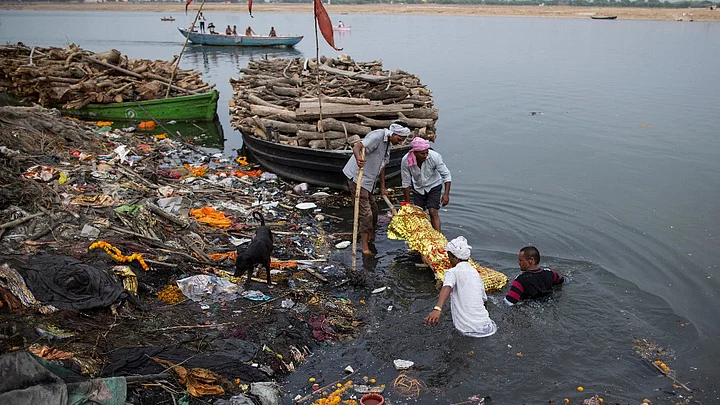In Jajmau, the epicentre of a legal and political battle to save India’s holiest river, the Ganga turns black. Tanneries in the Kanpur-Unnao industrial belt of Uttar Pradesh discharge effluents into the river, untreated. Toxic fumes make the air unbreathable.
“It’s so bad that even our utensils turn black,” Pankaj Kumar, who lives along the riverbanks, said.
Yet, highly polluting tanneries contribute to only 8 percent of the effluents that flow into the river, the Centre of Science and Environment said in a 2013 report. More than 70 percent of waste-water comes from paper, pulp and distilleries. To add to that, cities along the banks dump domestic sewage water into the river.
The Ganga is India’s largest river basin, covering 26 percent of the nation’s landmass and supporting 43 percent of its population, according to the CSE report. Along the entire stretch of the Ganga – and its tributaries, Kali and Ramganga – 764 industries consume 1,123 million litres of water, throwing back about half of that as effluents. About 90 percent of the industries are in Uttar Pradesh, India’s most populous state. And the stretch from Kanpur to Varanasi is the worst polluted.
So, are the tanneries being singled out?
Other industries and the domestic sewage pollute as well, Sushmita Sengupta, programme manager at CSE, told BloombergQuint. “But Kanpur is a hotspot. The tannery cluster lets out chromium that turns the river black.”
Agrees MC Mehta, environmental activist and lawyer, who filed a public interest litigation in the Supreme Court to save the Ganga more than three decades ago. All industries and domestic and hospital waste are responsible for the pollution, he said. “But tanneries are the most polluting.”
The National Green Tribunal last year ordered closure of about 100 of 402 registered tanneries along the Ganga. Another 100 have shut after the twin blows of demonetisation and the Goods and Services Tax. Uttar Pradesh Chief Minister Yogi Adityanath now wants the rest shifted out. The cluster, which contributes about a third of India’s leather exports, may not recover from the blow.
Khalid Nadri, who owns a small tannery in the area, says, “It would be disastrous if the industry is shifted and it could create huge job losses across the industry.”
However, the NGT has proposed setting up of another treatment plant in the area. “If this happens, it would save our industry from the losses,” he added.
The government’s Rs 20,000-crore flagship ‘Namami Gange’ plans to set up treatment plants for sewage and industrial effluents, besides beautifying the riverfronts. It’s the latest such plan and the first one was mooted as early as 1954, according to the CSE report.
In fact, a common effluent treatment plant was set up in Jajmau in 1996, to treat nine million litres of water a day let out by 175 tanneries. Yet, as the number of leather units more than doubled, it proved insufficient.
In 2015, only half of the 26 million litres a day of tannery refuse that flowed into the river was sent to the plant, an NGT report said. The effluents at the plant too are hardly treated.
Tanneries have to install primary units to separate chromium. The water then flows into the common plant operated by the government.
We do primary treatment at our unit. But the secondary plant is over 20 years old and it’s no longer efficient. The NGT in its last order said that these plants need to be upgraded. We hope in the next two years this will be done with the government’s help.Taj Alam, Vice-Chairman, UP Leather Industries Association
Tannery owners say they are willing to comply with guidelines but have run into red tape.
“There are at least 10 departments that monitor the discharge. NAMAMI Ganga, UP Pollution Control Board, Central Pollution Control Board, National Ganga Basin, NGT, UP Jal Nigam, Nagar Nigam, etc,” said Qazi Naiyer Jamal of the local Leather Industries Welfare Association. “These departments should be coordinating with each other. We waste all our time and energy replying to letters we get from different tribunals.”
Most leather units are small and said setting up primary plants would cost them upwards of Rs 1 crore. “We are anyway facing a financial crisis as business has slowed down,” said Mohammad Sharif who operates a tannery in Jajmau. “Where will we get the money to upgrade the treatment plant? The government should provide some help.”
Saddaqat Ali, who runs a small workshop, blamed corruption for the state of the Ganga along Kanpur-Unnao stretch.
The leather units are less at fault, he said. “There is no end to corruption. The diesel that comes to the plant is sold off. They don’t operate the machines and the industry water goes directly into the river,” he said. “Till that ends, the Ganga will never be clean.”
Queries sent to the UP Pollution Control Board remained unanswered.
Environmentalist Mehta said the only way forward is to shift the cluster some 20 kilometres away from the river basin. And that’s just the beginning.
Other industries such as sugar, distilleries, chemicals, paper, and pulp are also responsible. I am not asking just for one industry. I am arguing against everybody.MC Mehta, Lawyer And Environmental Activist
(This article was originally published on BloombergQuint)
(Breathe In, Breathe Out: Are you finding it tough to breathe polluted air? Join hands with FIT to find #PollutionKaSolution. Send in your suggestions to fit@thequint.com or WhatsApp @ +919999008335)
